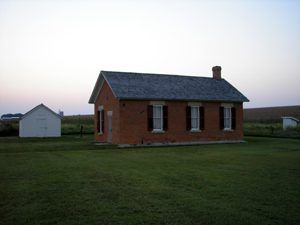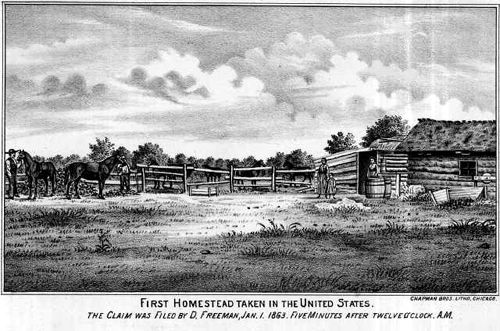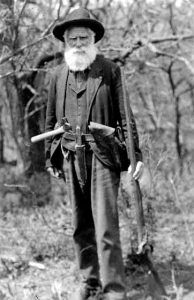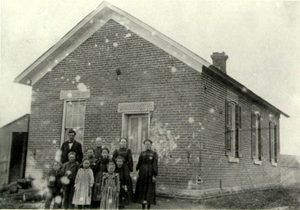By Addison Erwin Sheldon, 1913
The free homestead law has been called the most important act for the welfare of the people ever passed in the United States. Under this law, any man or woman twenty-one years old or the head of a family can have 160 acres of land by living on it for five years and paying about $18 in fees. No free homesteads existed for the first 80 years of United States history. The settlers were obliged to buy their land. The price was low, but they were often very poor and, in many cases, lost their land after living upon and improving it because they had no money to pay for it.
In 1852, the Free Soil Party demanded free homesteads for the people. In 1854, Congressman Galusha A. Grow of Pennsylvania introduced the first free homestead bill in Congress. The people of the West and poor people everywhere were in favor of the bill. However, there was strong opposition to it.
The first Homestead Act passed in 1860, required the settler to pay twenty-five cents an acre for his land. President Buchanan vetoed this bill. It was not until May 20, 1862, President Abraham Lincoln finally passed and signed the Free Homestead Act. The law took effect on January 1, 1863.
The first free homestead in the United States was taken by Daniel Freeman on Cub Creek in Gage County, Nebraska, about five miles northwest of Beatrice. Daniel Freeman was born in Ohio in 1826 and moved to Illinois with his parents in 1835. He was intensely interested in the Free Homestead Bill when it was first introduced in Congress. Year after year, he watched its progress and hoped for its passage, and many times, he said that he wished to be the first man to take a homestead.
When the Free Homestead Act was signed, Daniel Freeman was a soldier in the Union Army. A few months later, he was given a brief leave and came to Nebraska to look over the beautiful country, then lay vacant for a home. He found the place that suited him and started for the nearest United States land office, which was then at Brownville, Nebraska, arriving there on December 31, 1862.
The little town thronged with settlers coming there to take the land. All attended a New Year’s Eve party at the hotel that night. The new Homestead Act was to go into effect the next day, but as New Year’s was a holiday, the land office would not be open until January 2.
Mr. Freeman was ordered to join his regiment and expected to leave the next day. He told his story about his great desire to be the first homesteader in the United States. All the others agreed that he should have the first chance, and with him, they persuaded a clerk in the land office to open the office a few minutes past midnight on January 1 for Daniel Freeman alone.

The Palmer-Epard Cabin, built in 1867, was originally located 14 miles northeast of Freeman’s homestead. It was moved to Homestead National Monument in June 1950. Photo by Kathy Alexander.
So it came that Daniel Freeman made homestead entry number one and afterward received homestead patent number one for 160 acres on Cub Creek near Beatrice. Thus, Nebraska is honored to have the first homestead in the United States. Since then, over 1,000,000 homesteaders have followed Daniel Freeman’s example, receiving over 120,000,000 acres of land as a gift from our government. Of these homesteaders over 100,000 have lived in Nebraska. Nothing has helped so much in the settlement of the West as its free lands. One of the songs sung everywhere after the passage of the Homestead Act had for its refrain these words:
“Come along, come along, make no delay,
Come from every nation, come from every way,
Our lands they are broad enough, have no alarm
For Uncle Sam is rich enough to give us all a farm.”
Daniel Freeman served his country in the Union Army until the close of the Civil War in 1865. Then, he brought his bride and settled on his Nebraska homestead. This has remained ever since the family home. Here, their seven children grew to manhood and womanhood, and Mrs. Freeman lived with children and grandchildren.
Mr. Freeman died on December 30, 1908. This first homestead is a beautiful farm in the valley where the prairie and timber land join. The old log cabin with a sod roof, which was the first home of the Freeman family, has long since disappeared.
There is a brick house and orchard, and an old freighting road from the Missouri River to the mountains runs for nearly a mile through the place, with rows of giant cottonwoods planted by Mr. Freeman on either side. On the hill at one corner of the farm, overlooking the valley and the freighting road, is the grave of Daniel Freeman. It is proposed that the United States purchase this first homestead from the Freeman family and make it a public park to commemorate what is regarded as the most important law passed by the United States and the place where that law was first applied.
Addison Erwin Sheldon, 1913. Compiled and edited by Kathy Alexander/Legends of America, updated March 2024.
Excerpted from the book History and Stories of Nebraska by Addison Erwin Sheldon, 1913. (now in the public domain.) Addison Erwin Sheldon (1861-1943) was the director of the Nebraska Historical Society and wrote numerous books devoted to the history of Nebraska. Sheldon also took and drew many of the photographs and illustrations in his many texts.

The Freeman School is recognized as the longest-running one-room schoolhouse in Nebraska, open from 1872 to 1967. The National Park Service has restored the interior to look much like it did in the 1880s. Photo by Kathy Alexander.
Follow-up to Sheldon’s Historic Tale:
Agnes Suiter Freeman lived on the homestead until shortly before she died in 1931. In 1936, by an act of the United States Congress, the site of Freeman’s homestead was recognized as the “first” homestead in the United States when it was designated the Homestead National Monument of America. The national monument comprises the original homestead claim of Daniel Freeman, the Freeman School, constructed in 1872, one other historic cabin, Freeman’s grave, and tree plantings. The National Park Service administers the property. Homestead National Monument of America is located in southeastern Nebraska, 40 miles south of Lincoln and four miles west of Beatrice on NE Highway 4.
Contact Information:
Homestead National Monument
8523 W. State Highway 4
Beatrice, Nebraska 68310
402-223-3514
Also See:



